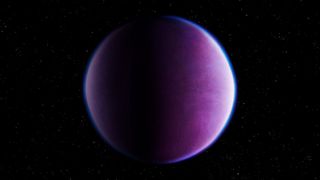Sorry, little green men: Alien life might actually be purple
"We are just opening our eyes to these fascinating worlds around us."

If we discover alien life, what will it look like?
We have no way of knowing, but the hunt for extraterrestrial life can now include purple bacteria, according to a group of astronomers who are recording the chemical makeup unique to the lavender-hued organisms. These microbes may have dominated Earth early on in our planet's history and are well-suited to emerge on faraway worlds that circle dim red stars smaller than our sun, a new study suggests.
The latest cataloging effort is in part "to create a database for signs of life to make sure our telescopes don't miss life if it happens not to look exactly like what we encounter around us every day," study co-author Lisa Kaltenegger of Cornell University said in a statement. "Purple bacteria can survive and thrive under such a variety of conditions that it is easy to imagine that on many different worlds, purple may just be the new green."
Related: How exotic alien life could thrive in the giant molecular clouds of deep space
On Earth — the only planet we know of where life exists and thus our best guide in the hunt for extraterrestrial life — life sustains itself on oxygen-producing photosynthesis driven by chlorophyll, the familiar green pigment utilized by most organisms to harness sunlight. This wasn't the case until roughly 2.4 billion years ago, when tiny blue-green algae called cyanobacteria, the first known species to photosynthesize, began using chlorophyll to harness sunlight and carbon dioxide for metabolic energy, and released oxygen as a byproduct.
Prior to that, microorganisms generated metabolic energy by harnessing sunlight using a purple-pigmented molecule called retinal, whose origin may have predated chlorophyll. If retinal exists on other faraway worlds, scientists think the molecule's unique fingerprint would be discernible by upcoming ground- and space-based telescopes.
"They already thrive here in certain niches," said study lead author Lígia Fonseca Coelho of the Carl Sagan Institute in New York. "Just imagine if they were not competing with green plants, algae and bacteria: A red sun could give them the most favorable conditions for photosynthesis."
Get the Space.com Newsletter
Breaking space news, the latest updates on rocket launches, skywatching events and more!
The current search for alien life is biased toward looking for green pigments, primarily because of limited measurements of organisms of other colors including purple, Coelho and her team argue. To develop a catalog of the chemical makeup of purple organisms, the researchers grew purple bacteria collected from different places — including shallow pond waters at Cornell, Massachusetts's Cape Cod and deep-sea hydrothermal vents — and measured their unique fingerprints. In subsequent simulations, they modeled purple bacteria dominating a variety of Earth-sized planets, including ocean worlds, frozen icy orbs and terrestrial rocky spheres like Earth.
The virtual purple bacteria produced detectable biosignatures, providing astronomers a new data set to inform next-generation telescopes in the search for alien life, like the European Extremely Large Telescope being constructed in Chile and NASA's Habitable Worlds Observatory, an infrared telescope currently scheduled for launch around 2040.
"We are just opening our eyes to these fascinating worlds around us," said Kaltenegger.
The findings are described in a paper published April 16 in the journal Monthly Notices of the Royal Astronomical Society: Letters.
Join our Space Forums to keep talking space on the latest missions, night sky and more! And if you have a news tip, correction or comment, let us know at: community@space.com.

Sharmila Kuthunur is a Seattle-based science journalist covering astronomy, astrophysics and space exploration. Follow her on X @skuthunur.
-
DC8Captain Reply
Well...Vulcans have green blood.Admin said:The search for alien life can now include purple bacteria, thanks to a new catalog of chemical makeup of the lavender-hued organisms.
Sorry, little green men: Alien life might actually be purple : Read more -
Planet Seer Reply
I believe that was supposed to be due to copper-based blood instead of Iron-based.DC8Captain said:Well...Vulcans have green blood. -
Frank Sterle Jr An extraterrestrial attack or invasion is what humankind may collectively need to brutally endure in order to survive the very-long-term from ourselves.Reply
Humanity could all unite for the first time ever to defend against, attack and defeat the humanicidal multi-tentacled ETs, the latter needing to be an even greater nemesis than our own formidably divisive politics and perceptions of differences, both real and perceived — especially those involving color and race.
During this much-needed human allegiance, we’d be forced to work closely side-by-side together and witness just how humanly similar we are to each other in every significant way. (But then I’ve been informed that one or more human parties might actually attempt to forge an allegiance with the ETs to better their own chances for survival, thus indicating that our deficient human condition may be even worse than I had originally thought.)
Still, maybe some five or more decades later when all traces of the nightmarish ET invasion are gone, we'll inevitably revert to those same politics to which we humans seem so hopelessly collectively and maybe even individually prone — including those of scale: the intercontinental, international, national, provincial or state, regional and municipal. And again we slide downwards.
It’s quite plausible that if the world’s population was somehow reduced to just a few city blocks of seemingly similar residents, there’d sooner or later be some form of notable inter-neighborhood hostilities.
